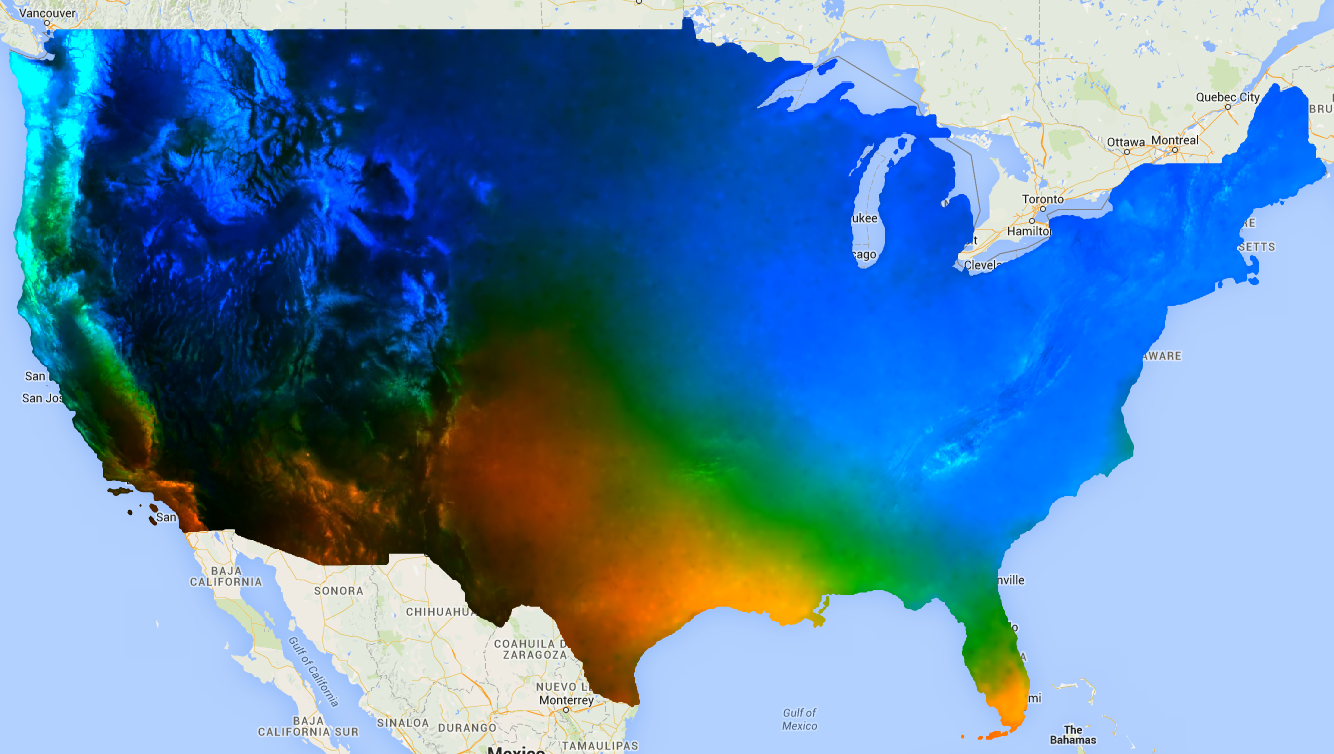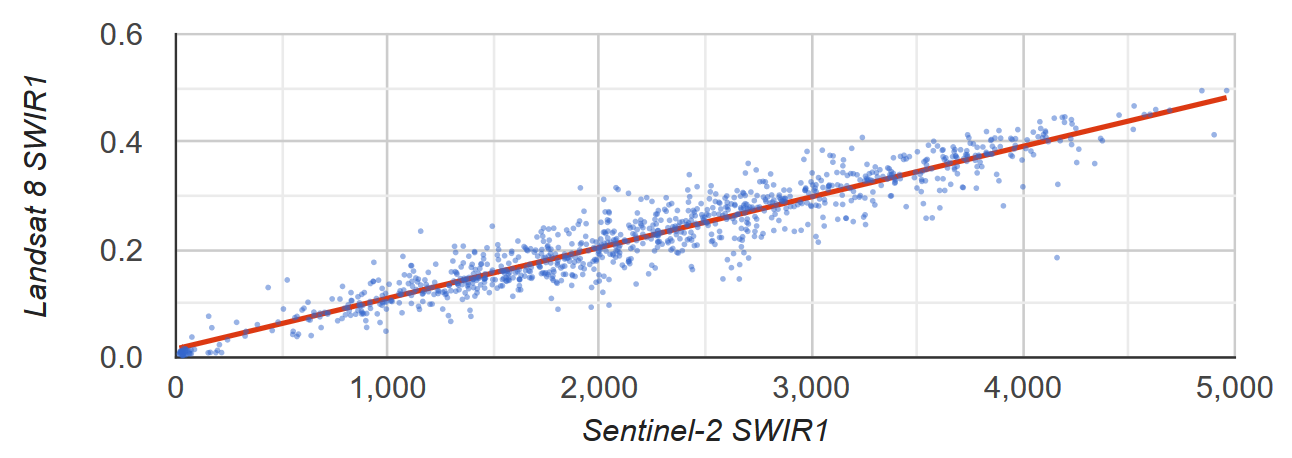Earth Engine 提供多種方法,可使用減法器執行線性迴歸:
ee.Reducer.linearFit()ee.Reducer.linearRegression()ee.Reducer.robustLinearRegression()ee.Reducer.ridgeRegression()
最簡單的線性迴歸縮減器是 linearFit(),可計算單一變數線性函數的常數項最小平方估計值。如要採用更靈活的線性建模方法,請使用其中一個線性迴歸縮減器,允許變數數量的獨立和從屬變數。linearRegression() 會實作一般最小平方迴歸法(OLS)。robustLinearRegression() 會使用以迴歸殘差為基礎的成本函式,以便逐步降低資料中的異常值權重 (O’Leary, 1990)。ridgeRegression() 會使用 L2 正則化進行線性迴歸。
使用這些方法進行迴歸分析,適合用於減少 ee.ImageCollection、ee.Image、ee.FeatureCollection 和 ee.List 物件。以下範例說明每個類型的應用程式。請注意,linearRegression()、robustLinearRegression() 和 ridgeRegression() 都具有相同的輸入和輸出結構,但 linearFit() 預期會收到雙頻帶輸入內容 (X 後面接著 Y),而 ridgeRegression() 則有額外的參數 (lambda,選用) 和輸出內容 (pValue)。
ee.ImageCollection
linearFit()
資料應設為雙頻帶輸入圖片,其中第一個頻帶是獨立變數,第二個頻帶是相依變數。以下範例顯示氣候模型預測的未來降雨量線性趨勢 (NEX-DCP30 資料 中 2006 年後的資料)。相依變數是預估降雨量,獨立變數則是時間,這兩個變數會在呼叫 linearFit() 之前新增:
程式碼編輯器 (JavaScript)
// This function adds a time band to the image. var createTimeBand = function(image) { // Scale milliseconds by a large constant to avoid very small slopes // in the linear regression output. return image.addBands(image.metadata('system:time_start').divide(1e18)); }; // Load the input image collection: projected climate data. var collection = ee.ImageCollection('NASA/NEX-DCP30_ENSEMBLE_STATS') .filter(ee.Filter.eq('scenario', 'rcp85')) .filterDate(ee.Date('2006-01-01'), ee.Date('2050-01-01')) // Map the time band function over the collection. .map(createTimeBand); // Reduce the collection with the linear fit reducer. // Independent variable are followed by dependent variables. var linearFit = collection.select(['system:time_start', 'pr_mean']) .reduce(ee.Reducer.linearFit()); // Display the results. Map.setCenter(-100.11, 40.38, 5); Map.addLayer(linearFit, {min: 0, max: [-0.9, 8e-5, 1], bands: ['scale', 'offset', 'scale']}, 'fit');
請注意,輸出內容包含兩個頻帶:「偏移」(截距) 和「比例」(在此情況下是指線的斜率,請勿與輸入至多個縮減器的比例參數混淆,後者是空間比例)。結果會顯示藍色區域代表趨勢上升、紅色區域代表趨勢下降,而綠色區域代表沒有趨勢,如圖 1 所示。

圖 1. linearFit() 的輸出內容已套用至預估降雨量。預測降雨量增加的區域會以藍色顯示,降雨量減少的區域則會以紅色顯示。
linearRegression()
舉例來說,假設有兩個從屬變數:降雨量和最高溫度,以及兩個獨立變數:常數和時間。集合與前一個範例相同,但必須在縮減前手動新增常數頻帶。輸入內容的前兩個頻帶是「X」(獨立) 變數,後兩個頻帶則是「Y」(相依) 變數。在本例中,您會先取得迴歸係數,然後將陣列圖片平坦化,以便擷取感興趣的頻帶:
程式碼編輯器 (JavaScript)
// This function adds a time band to the image. var createTimeBand = function(image) { // Scale milliseconds by a large constant. return image.addBands(image.metadata('system:time_start').divide(1e18)); }; // This function adds a constant band to the image. var createConstantBand = function(image) { return ee.Image(1).addBands(image); }; // Load the input image collection: projected climate data. var collection = ee.ImageCollection('NASA/NEX-DCP30_ENSEMBLE_STATS') .filterDate(ee.Date('2006-01-01'), ee.Date('2099-01-01')) .filter(ee.Filter.eq('scenario', 'rcp85')) // Map the functions over the collection, to get constant and time bands. .map(createTimeBand) .map(createConstantBand) // Select the predictors and the responses. .select(['constant', 'system:time_start', 'pr_mean', 'tasmax_mean']); // Compute ordinary least squares regression coefficients. var linearRegression = collection.reduce( ee.Reducer.linearRegression({ numX: 2, numY: 2 })); // Compute robust linear regression coefficients. var robustLinearRegression = collection.reduce( ee.Reducer.robustLinearRegression({ numX: 2, numY: 2 })); // The results are array images that must be flattened for display. // These lists label the information along each axis of the arrays. var bandNames = [['constant', 'time'], // 0-axis variation. ['precip', 'temp']]; // 1-axis variation. // Flatten the array images to get multi-band images according to the labels. var lrImage = linearRegression.select(['coefficients']).arrayFlatten(bandNames); var rlrImage = robustLinearRegression.select(['coefficients']).arrayFlatten(bandNames); // Display the OLS results. Map.setCenter(-100.11, 40.38, 5); Map.addLayer(lrImage, {min: 0, max: [-0.9, 8e-5, 1], bands: ['time_precip', 'constant_precip', 'time_precip']}, 'OLS'); // Compare the results at a specific point: print('OLS estimates:', lrImage.reduceRegion({ reducer: ee.Reducer.first(), geometry: ee.Geometry.Point([-96.0, 41.0]), scale: 1000 })); print('Robust estimates:', rlrImage.reduceRegion({ reducer: ee.Reducer.first(), geometry: ee.Geometry.Point([-96.0, 41.0]), scale: 1000 }));
檢查結果,即可發現 linearRegression() 輸出結果等同於 linearFit() 縮減器估算的係數,但 linearRegression() 輸出結果也包含其他依附變數 tasmax_mean 的係數。穩健線性迴歸係數與 OLS 估計值不同。本範例會比較不同迴歸方法在特定時間點的係數。
ee.Image
在 ee.Image 物件的內容中,您可以搭配使用迴歸縮減器和 reduceRegion 或 reduceRegions,針對區域中的像素執行線性迴歸。以下範例說明如何計算任意多邊形內 Landsat 波段之間的迴歸係數。
linearFit()
說明陣列資料圖表的指南章節中,顯示了 Landsat 8 SWIR1 和 SWIR2 頻帶之間關聯性的散布圖。此處會計算此關係的線性迴歸係數。系統會傳回字典,其中包含 'offset' (y 軸交點) 和 'scale' (斜率) 屬性。
程式碼編輯器 (JavaScript)
// Define a rectangle geometry around San Francisco. var sanFrancisco = ee.Geometry.Rectangle([-122.45, 37.74, -122.4, 37.8]); // Import a Landsat 8 TOA image for this region. var img = ee.Image('LANDSAT/LC08/C02/T1_TOA/LC08_044034_20140318'); // Subset the SWIR1 and SWIR2 bands. In the regression reducer, independent // variables come first followed by the dependent variables. In this case, // B5 (SWIR1) is the independent variable and B6 (SWIR2) is the dependent // variable. var imgRegress = img.select(['B5', 'B6']); // Calculate regression coefficients for the set of pixels intersecting the // above defined region using reduceRegion with ee.Reducer.linearFit(). var linearFit = imgRegress.reduceRegion({ reducer: ee.Reducer.linearFit(), geometry: sanFrancisco, scale: 30, }); // Inspect the results. print('OLS estimates:', linearFit); print('y-intercept:', linearFit.get('offset')); print('Slope:', linearFit.get('scale'));
linearRegression()
這裡會套用先前 linearFit 部分的相同分析,但這次會使用 ee.Reducer.linearRegression 函式。請注意,回歸圖片是由三張獨立圖片建構而成:一張常數圖片,以及代表同一張 Landsat 8 圖片的 SWIR1 和 SWIR2 頻帶圖片。請注意,您可以結合任何一組頻帶,透過 ee.Reducer.linearRegression 建構用於區域縮減的輸入圖像,這些頻帶不必屬於相同的來源圖像。
程式碼編輯器 (JavaScript)
// Define a rectangle geometry around San Francisco. var sanFrancisco = ee.Geometry.Rectangle([-122.45, 37.74, -122.4, 37.8]); // Import a Landsat 8 TOA image for this region. var img = ee.Image('LANDSAT/LC08/C02/T1_TOA/LC08_044034_20140318'); // Create a new image that is the concatenation of three images: a constant, // the SWIR1 band, and the SWIR2 band. var constant = ee.Image(1); var xVar = img.select('B5'); var yVar = img.select('B6'); var imgRegress = ee.Image.cat(constant, xVar, yVar); // Calculate regression coefficients for the set of pixels intersecting the // above defined region using reduceRegion. The numX parameter is set as 2 // because the constant and the SWIR1 bands are independent variables and they // are the first two bands in the stack; numY is set as 1 because there is only // one dependent variable (SWIR2) and it follows as band three in the stack. var linearRegression = imgRegress.reduceRegion({ reducer: ee.Reducer.linearRegression({ numX: 2, numY: 1 }), geometry: sanFrancisco, scale: 30, }); // Convert the coefficients array to a list. var coefList = ee.Array(linearRegression.get('coefficients')).toList(); // Extract the y-intercept and slope. var b0 = ee.List(coefList.get(0)).get(0); // y-intercept var b1 = ee.List(coefList.get(1)).get(0); // slope // Extract the residuals. var residuals = ee.Array(linearRegression.get('residuals')).toList().get(0); // Inspect the results. print('OLS estimates', linearRegression); print('y-intercept:', b0); print('Slope:', b1); print('Residuals:', residuals);
系統會傳回包含 'coefficients' 和 'residuals' 屬性的字典。'coefficients' 屬性是具有 (numX, numY) 維度的陣列,每個資料欄都包含對應依附變數的係數。在本例中,陣列有兩列和一個欄;第一列第一欄是 y 截距,第二列第一欄是斜率。'residuals' 屬性是各個依附變數殘差的平方根均方向量。您可以將結果轉換為陣列,然後切片所需的元素,或將陣列轉換為清單,並依索引位置選取係數,藉此擷取係數。
ee.FeatureCollection
假設您想瞭解 Sentinel-2 和 Landsat 8 SWIR1 反射率之間的線性關係。在本例中,我們使用以點為特徵集合的隨機像素樣本,計算關係。系統會產生像素組成的散布圖,以及最小二乘式最佳擬合線 (圖 2)。
程式碼編輯器 (JavaScript)
// Import a Sentinel-2 TOA image. var s2ImgSwir1 = ee.Image('COPERNICUS/S2/20191022T185429_20191022T185427_T10SEH'); // Import a Landsat 8 TOA image from 12 days earlier than the S2 image. var l8ImgSwir1 = ee.Image('LANDSAT/LC08/C02/T1_TOA/LC08_044033_20191010'); // Get the intersection between the two images - the area of interest (aoi). var aoi = s2ImgSwir1.geometry().intersection(l8ImgSwir1.geometry()); // Get a set of 1000 random points from within the aoi. A feature collection // is returned. var sample = ee.FeatureCollection.randomPoints({ region: aoi, points: 1000 }); // Combine the SWIR1 bands from each image into a single image. var swir1Bands = s2ImgSwir1.select('B11') .addBands(l8ImgSwir1.select('B6')) .rename(['s2_swir1', 'l8_swir1']); // Sample the SWIR1 bands using the sample point feature collection. var imgSamp = swir1Bands.sampleRegions({ collection: sample, scale: 30 }) // Add a constant property to each feature to be used as an independent variable. .map(function(feature) { return feature.set('constant', 1); }); // Compute linear regression coefficients. numX is 2 because // there are two independent variables: 'constant' and 's2_swir1'. numY is 1 // because there is a single dependent variable: 'l8_swir1'. Cast the resulting // object to an ee.Dictionary for easy access to the properties. var linearRegression = ee.Dictionary(imgSamp.reduceColumns({ reducer: ee.Reducer.linearRegression({ numX: 2, numY: 1 }), selectors: ['constant', 's2_swir1', 'l8_swir1'] })); // Convert the coefficients array to a list. var coefList = ee.Array(linearRegression.get('coefficients')).toList(); // Extract the y-intercept and slope. var yInt = ee.List(coefList.get(0)).get(0); // y-intercept var slope = ee.List(coefList.get(1)).get(0); // slope // Gather the SWIR1 values from the point sample into a list of lists. var props = ee.List(['s2_swir1', 'l8_swir1']); var regressionVarsList = ee.List(imgSamp.reduceColumns({ reducer: ee.Reducer.toList().repeat(props.size()), selectors: props }).get('list')); // Convert regression x and y variable lists to an array - used later as input // to ui.Chart.array.values for generating a scatter plot. var x = ee.Array(ee.List(regressionVarsList.get(0))); var y1 = ee.Array(ee.List(regressionVarsList.get(1))); // Apply the line function defined by the slope and y-intercept of the // regression to the x variable list to create an array that will represent // the regression line in the scatter plot. var y2 = ee.Array(ee.List(regressionVarsList.get(0)).map(function(x) { var y = ee.Number(x).multiply(slope).add(yInt); return y; })); // Concatenate the y variables (Landsat 8 SWIR1 and predicted y) into an array // for input to ui.Chart.array.values for plotting a scatter plot. var yArr = ee.Array.cat([y1, y2], 1); // Make a scatter plot of the two SWIR1 bands for the point sample and include // the least squares line of best fit through the data. print(ui.Chart.array.values({ array: yArr, axis: 0, xLabels: x}) .setChartType('ScatterChart') .setOptions({ legend: {position: 'none'}, hAxis: {'title': 'Sentinel-2 SWIR1'}, vAxis: {'title': 'Landsat 8 SWIR1'}, series: { 0: { pointSize: 0.2, dataOpacity: 0.5, }, 1: { pointSize: 0, lineWidth: 2, } } }) );

圖 2. 散布圖和最小平方迴歸線,代表 Sentinel-2 和 Landsat 8 SWIR1 TOA 反射率的像素樣本。
ee.List
2D ee.List 物件的欄可做為迴歸縮減器的輸入內容。以下範例提供簡單的證明;獨立變數是相依變數的副本,產生的 y 截距等於 0,斜率等於 1。
linearFit()
程式碼編輯器 (JavaScript)
// Define a list of lists, where columns represent variables. The first column // is the independent variable and the second is the dependent variable. var listsVarColumns = ee.List([ [1, 1], [2, 2], [3, 3], [4, 4], [5, 5] ]); // Compute the least squares estimate of a linear function. Note that an // object is returned; cast it as an ee.Dictionary to make accessing the // coefficients easier. var linearFit = ee.Dictionary(listsVarColumns.reduce(ee.Reducer.linearFit())); // Inspect the result. print(linearFit); print('y-intercept:', linearFit.get('offset')); print('Slope:', linearFit.get('scale'));
如果變數以資料列表示,請將清單轉置,方法是將其轉換為 ee.Array、轉置,然後再轉換回 ee.List。
程式碼編輯器 (JavaScript)
// If variables in the list are arranged as rows, you'll need to transpose it. // Define a list of lists where rows represent variables. The first row is the // independent variable and the second is the dependent variable. var listsVarRows = ee.List([ [1, 2, 3, 4, 5], [1, 2, 3, 4, 5] ]); // Cast the ee.List as an ee.Array, transpose it, and cast back to ee.List. var listsVarColumns = ee.Array(listsVarRows).transpose().toList(); // Compute the least squares estimate of a linear function. Note that an // object is returned; cast it as an ee.Dictionary to make accessing the // coefficients easier. var linearFit = ee.Dictionary(listsVarColumns.reduce(ee.Reducer.linearFit())); // Inspect the result. print(linearFit); print('y-intercept:', linearFit.get('offset')); print('Slope:', linearFit.get('scale'));
linearRegression()
ee.Reducer.linearRegression() 的應用方式與上述 linearFit() 範例類似,差別在於包含了常數獨立變數。
程式碼編輯器 (JavaScript)
// Define a list of lists where columns represent variables. The first column // represents a constant term, the second an independent variable, and the third // a dependent variable. var listsVarColumns = ee.List([ [1, 1, 1], [1, 2, 2], [1, 3, 3], [1, 4, 4], [1, 5, 5] ]); // Compute ordinary least squares regression coefficients. numX is 2 because // there is one constant term and an additional independent variable. numY is 1 // because there is only a single dependent variable. Cast the resulting // object to an ee.Dictionary for easy access to the properties. var linearRegression = ee.Dictionary( listsVarColumns.reduce(ee.Reducer.linearRegression({ numX: 2, numY: 1 }))); // Convert the coefficients array to a list. var coefList = ee.Array(linearRegression.get('coefficients')).toList(); // Extract the y-intercept and slope. var b0 = ee.List(coefList.get(0)).get(0); // y-intercept var b1 = ee.List(coefList.get(1)).get(0); // slope // Extract the residuals. var residuals = ee.Array(linearRegression.get('residuals')).toList().get(0); // Inspect the results. print('OLS estimates', linearRegression); print('y-intercept:', b0); print('Slope:', b1); print('Residuals:', residuals);
